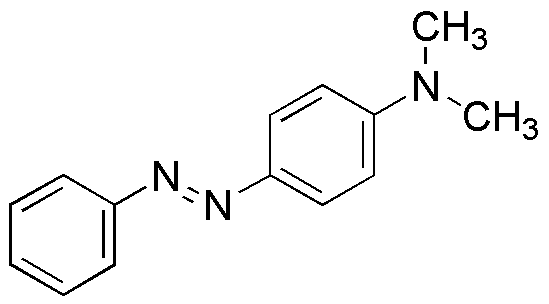4-Dimethylaminoazobenzene is widely utilized in research focused on:
- Dyes and Pigments: This compound is a key ingredient in the production of azo dyes, which are used in textiles, food, and cosmetics, offering vibrant colors and excellent stability.
- Biological Research: It serves as a model compound in studies of carcinogenicity, helping researchers understand the mechanisms of cancer development and the effects of chemical exposure.
- Analytical Chemistry: Used as a reagent in various analytical techniques, it aids in the detection and quantification of other substances, enhancing the accuracy of chemical analysis.
- Photochemistry: This compound is employed in photochemical studies to explore light-induced reactions, contributing to advancements in solar energy and photonic devices.
- Polymer Chemistry: It is utilized in the synthesis of polymeric materials, providing unique properties such as color stability and thermal resistance, which are beneficial in manufacturing processes.
General Information
Properties
Safety and Regulations
Applications
4-Dimethylaminoazobenzene is widely utilized in research focused on:
- Dyes and Pigments: This compound is a key ingredient in the production of azo dyes, which are used in textiles, food, and cosmetics, offering vibrant colors and excellent stability.
- Biological Research: It serves as a model compound in studies of carcinogenicity, helping researchers understand the mechanisms of cancer development and the effects of chemical exposure.
- Analytical Chemistry: Used as a reagent in various analytical techniques, it aids in the detection and quantification of other substances, enhancing the accuracy of chemical analysis.
- Photochemistry: This compound is employed in photochemical studies to explore light-induced reactions, contributing to advancements in solar energy and photonic devices.
- Polymer Chemistry: It is utilized in the synthesis of polymeric materials, providing unique properties such as color stability and thermal resistance, which are beneficial in manufacturing processes.
Documents
Safety Data Sheets (SDS)
The SDS provides comprehensive safety information on handling, storage, and disposal of the product.
Product Specification (PS)
The PS provides a comprehensive breakdown of the product’s properties, including chemical composition, physical state, purity, and storage requirements. It also details acceptable quality ranges and the product's intended applications.
Certificates of Analysis (COA)
Search for Certificates of Analysis (COA) by entering the products Lot Number. Lot and Batch Numbers can be found on a product’s label following the words ‘Lot’ or ‘Batch’.
*Catalog Number
*Lot Number
Certificates Of Origin (COO)
This COO confirms the country where the product was manufactured, and also details the materials and components used in it and whether it is derived from natural, synthetic, or other specific sources. This certificate may be required for customs, trade, and regulatory compliance.
*Catalog Number
*Lot Number
Safety Data Sheets (SDS)
The SDS provides comprehensive safety information on handling, storage, and disposal of the product.
DownloadProduct Specification (PS)
The PS provides a comprehensive breakdown of the product’s properties, including chemical composition, physical state, purity, and storage requirements. It also details acceptable quality ranges and the product's intended applications.
DownloadCertificates of Analysis (COA)
Search for Certificates of Analysis (COA) by entering the products Lot Number. Lot and Batch Numbers can be found on a product’s label following the words ‘Lot’ or ‘Batch’.
*Catalog Number
*Lot Number
Certificates Of Origin (COO)
This COO confirms the country where the product was manufactured, and also details the materials and components used in it and whether it is derived from natural, synthetic, or other specific sources. This certificate may be required for customs, trade, and regulatory compliance.


